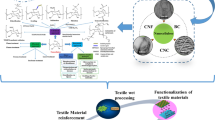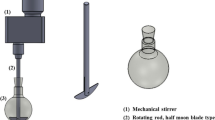Abstract
In this work, a large size of macroporous phenolic resin (PR)/bacterial cellulose (BC) composite with double-network structure was fabricated simply by soaking, heating, solvent exchange, and ambient pressure drying. The mechanism and influence factors for the fabrication of this macroporous composite were systematically elaborated. One network of macroporous composite was composed of PR beads, and the other derived from original BC nanofibers. They supported and reinforced each other, avoiding the collapse of interconnected porous structure and achieving low density (0.29 g/cm3), high porosity (77.7%), low thermal conductivity (0.10 W/m K), and excellent compressive strength (7.97 ± 2.24 MPa). Through further carbonization, carbon counterpart that maintained fine structure and good performance can also be obtained. The surface of macroporous composite was extremely hydrophilic. On the contrary, its carbon counterpart possessed a highly hydrophobic surface (contact angle = 118.2°). These properties suggest that the macroporous composite and carbon counterpart may have potential applications for filtration, separation, and thermal insulation materials. Moreover, this work will provide a novel perspective for the fabrication of porous composites with BC as the template and 3D nanofiber reinforcement simultaneously.
Graphic abstract









Similar content being viewed by others
References
Al-Muhtaseb SA, Ritter JA (2003) Preparation and properties of resorcinol–formaldehyde organic and carbon gels. Adv Mater 15:101–114
Bai Q, Xiong Q, Li C, Shen Y, Uyama H (2017) Hierarchical porous carbons from poly(methyl methacrylate)/bacterial cellulose composite monolith for high-performance supercapacitor electrodes. ACS Sustain Chem Eng 5:9390–9401
Bock V, Emmerling A, Fricke J (1998) Influence of monomer and catalyst concentration on RF and carbon aerogel structure. J Non-Cryst Solids 225:69–73
Chen LF, Huang ZH, Liang HW, Yao WT, Yu ZY, Yu SH (2013) Flexible all-solid-state high-power supercapacitor fabricated with nitrogen-doped carbon nanofiber electrode material derived from bacterial cellulose. Energy Environ Sci 6:3331–3338
Cuce E, Cuce PM, Wood CJ, Riffat SB (2014) Toward aerogel based thermal superinsulation in buildings: a comprehensive review. Renew Sustain Energy Rev 34:273–299
Czakkel O, Marthi K, Geissler E, László K (2005) Influence of drying on the morphology of resorcinol–formaldehyde-based carbon gels. Micropor Mesopor Mater 86:124–133
Dobashi A, Maruyama J, Shen Y, Nandi M, Uyama H (2018) Activated carbon monoliths derived from bacterial cellulose/polyacrylonitrile composite as new generation electrode materials in EDLC. Carbohydr Polym 200:381–390
Fairén-Jiménez D, Carrasco-Marín F, Moreno-Castilla C (2006) Porosity and surface area of monolithic carbon aerogels prepared using alkaline carbonates and organic acids as polymerization catalysts. Carbon 44:2301–2307
Fu L, Zhang J, Yang G (2013) Present status and applications of bacterial cellulose-based materials for skin tissue repair. Carbohydr Polym 92:1432–1442
Giesche H (2006) Mercury porosimetry: a general (practical) overview. Part Part Syst Charact 23:9–19
Gupta S, Tai NH (2016) Carbon materials as oil sorbents: a review on the synthesis and performance. J Mater Chem A 4:1550–1565
Hirano K, Asami M (2013) Phenolic resins—100 years of progress and their future. React Funct Polym 73:256–269
Horikawa T, Hayashi J, Muroyama K (2004) Controllability of pore characteristics of resorcinol–formaldehyde carbon aerogel. Carbon 42:1625–1633
Huang Y, Zhu C, Yang J, Nie Y, Chen C, Sun D (2014) Recent advances in bacterial cellulose. Cellulose 21:1–30
Iguchi M, Yamanaka S, Budhiono A (2000) Bacterial cellulose - a masterpiece of nature's arts. J Mater Sci 35:261–270
Janik H, Marzec M (2015) A review: Fabrication of porous polyurethane scaffolds. Mater Sci Eng C 48:586–591
Job N, Panariello F, Marien J, Crine M, Pirard JP, Léonard A (2006) Synthesis optimization of organic xerogels produced from convective air-drying of resorcinol–formaldehyde gels. J Non-Cryst Solids 352:24–34
Job N et al (2005) Carbon aerogels, cryogels and xerogels: Influence of the drying method on the textural properties of porous carbon materials. Carbon 43:2481–2494
Klemm D, Heublein B, Fink HP, Bohn A (2005) Cellulose: Fascinating biopolymer and sustainable raw material. Angew Chem Int Ed 44:3358–3393
Kocklenberg R, Mathieu B, Blacher S, Pirard R, Pirard JP, Sobry R, Van den Bossche G (1998) Texture control of freeze-dried resorcinol–formaldehyde gels. J Non-Cryst Solids 225:8–13
León y León CA, (1998) New perspectives in mercury porosimetry. Adv Colloid Interface Sci 76–77:341–372
Léonard A, Job N, Blacher S, Pirard JP, Crine M, Jomaa W (2005) Suitability of convective air drying for the production of porous resorcinol-formaldehyde and carbon xerogels. Carbon 43:1808–1811
Liebner F et al (2010) Aerogels from unaltered bacterial cellulose: Application of scCO2 drying for the preparation of shaped, ultra-lightweight cellulosic aerogels. Macromol Biosci 10:349–352
Long C, Qi D, Wei T, Yan J, Jiang L, Fan Z (2014) Nitrogen-doped carbon networks for high energy density supercapacitors derived from polyaniline coated bacterial cellulose. Adv Funct Mater 24:3953–3961
Elkhatat AM, Al-Muhtaseb SA (2011) Advances in tailoring resorcinol-formaldehyde organic and carbon gels. Adv Mater 23:2887–2903
Nogi M, Yano H (2008) Transparent nanocomposites based on cellulose produced by bacteria offer potential innovation in the electronics device industry. Adv Mater 20:1849–1852
Pekala RW (1989) Organic aerogels from the polycondensation of resorcinol with formaldehyde. J Mater Sci 24:3221–3227
Pilato L (2010) Phenolic resins: A century of progress. Springer-Verlag, Berlin Heidelberg
Roberts AD, Li X, Zhang H (2014) Porous carbon spheres and monoliths: morphology control, pore size tuning and their applications as Li-ion battery anode materials. Chem Soc Rev 43:4341–4356
Shah N, Ul-Islam M, Khattak WA, Park JK (2013) Overview of bacterial cellulose composites: a multipurpose advanced material. Carbohydr Polym 98:1585–1598
Shu Y et al (2020) Hierarchical porous carbons from polysaccharides carboxymethyl cellulose, bacterial cellulose, and citric acid for supercapacitor. Carbohydr Polym 227:115346
Shi Z, Zhang Y, Phillips GO, Yang G (2014) Utilization of bacterial cellulose in food. Food Hydrocoll 35:539–545
Tamon H, Ishizaka H (2000) Influence of gelation temperature and catalysts on the mesoporous structure of resorcinol–formaldehyde aerogels. J Colloid Interface Sci 223:305–307
Wang H, Zhu E, Yang J, Zhou P, Sun D, Tang W (2012) Bacterial cellulose nanofiber-supported polyaniline nanocomposites with flake-shaped morphology as supercapacitor electrodes. J Phys Chem C 116:13013–13019
Wu D, Fu R, Zhang S, Dresselhaus MS, Dresselhaus G (2004) Preparation of low-density carbon aerogels by ambient pressure drying. Carbon 42:2033–2039
Wu ZY, Li C, Liang HW, Chen JF, Yu SH (2013) Ultralight, flexible, and fire-resistant carbon nanofiber aerogels from bacterial cellulose. Angew Chem 125:2997–3001
Wu ZY, Liang HW, Chen LF, Hu BC, Yu SH (2016) Bacterial cellulose: a robust platform for design of three dimensional carbon-based functional nanomaterials. Acc Chem Res 49:96–105
Zgrablich G, Mendioroz S, Daza L, Pajares J, Mayagoitia V, Rojas F, Conner WC (1991) Effect of porous structure on the determination of pore size distribution by mercury porosimetry and nitrogen sorption. Langmuir 7:779–785
Zhang B, Azuma J, Uyama H (2015) Preparation and characterization of a transparent amorphous cellulose film. RSC Adv 5:2900–2907
Zhang B, Uyama H (2016) Biomimic plant cuticle from hyperbranched poly(ricinoleic acid) and cellulose film. ACS Sustain Chem Eng 4:363–369
Zhang B, Yu H, Zhang Y, Luo Z, Han W, Qiu W, Zhao T (2018a) Bacterial cellulose derived monolithic titania aerogel consisting of 3D reticulate titania nanofibers. Cellulose 25:7189–7196
Zhang B, Zhang Y, Luo Z, Han W, Qiu W, Zhao T (2018b) Hierarchically porous zirconia monolith fabricated from bacterial cellulose and preceramic polymer. ACS Omega 3:4688–4694
Acknowledgments
The authors gratefully acknowledge the financial support from National Natural Science Foundation of China (No.21805092), Guangdong Innovative and Entrepreneurial Research Team Program (No.2016ZT06C322), and Fundamental Research Funds for the Central Universities (No.2018MS35).
Author information
Authors and Affiliations
Corresponding authors
Ethics declarations
Conflict of interest
The authors declare that they have no conflict of interest.
Additional information
Publisher's Note
Springer Nature remains neutral with regard to jurisdictional claims in published maps and institutional affiliations.
Electronic supplementary material
Below is the link to the electronic supplementary material.
10570_2020_3122_MOESM1_ESM.rar
Movie S1: demonstration of oil/water separation with macroporous PR/BC composite as a filter.Movie S2: CA test on the surface of macroporous PR/BC composite. (RAR 13765 kb)
Rights and permissions
About this article
Cite this article
Zhang, Bx., Zhang, Y., Li, J. et al. Tough macroporous phenolic resin/bacterial cellulose composite with double-network structure fabricated by ambient pressure drying. Cellulose 27, 5029–5039 (2020). https://doi.org/10.1007/s10570-020-03122-9
Received:
Accepted:
Published:
Issue Date:
DOI: https://doi.org/10.1007/s10570-020-03122-9




